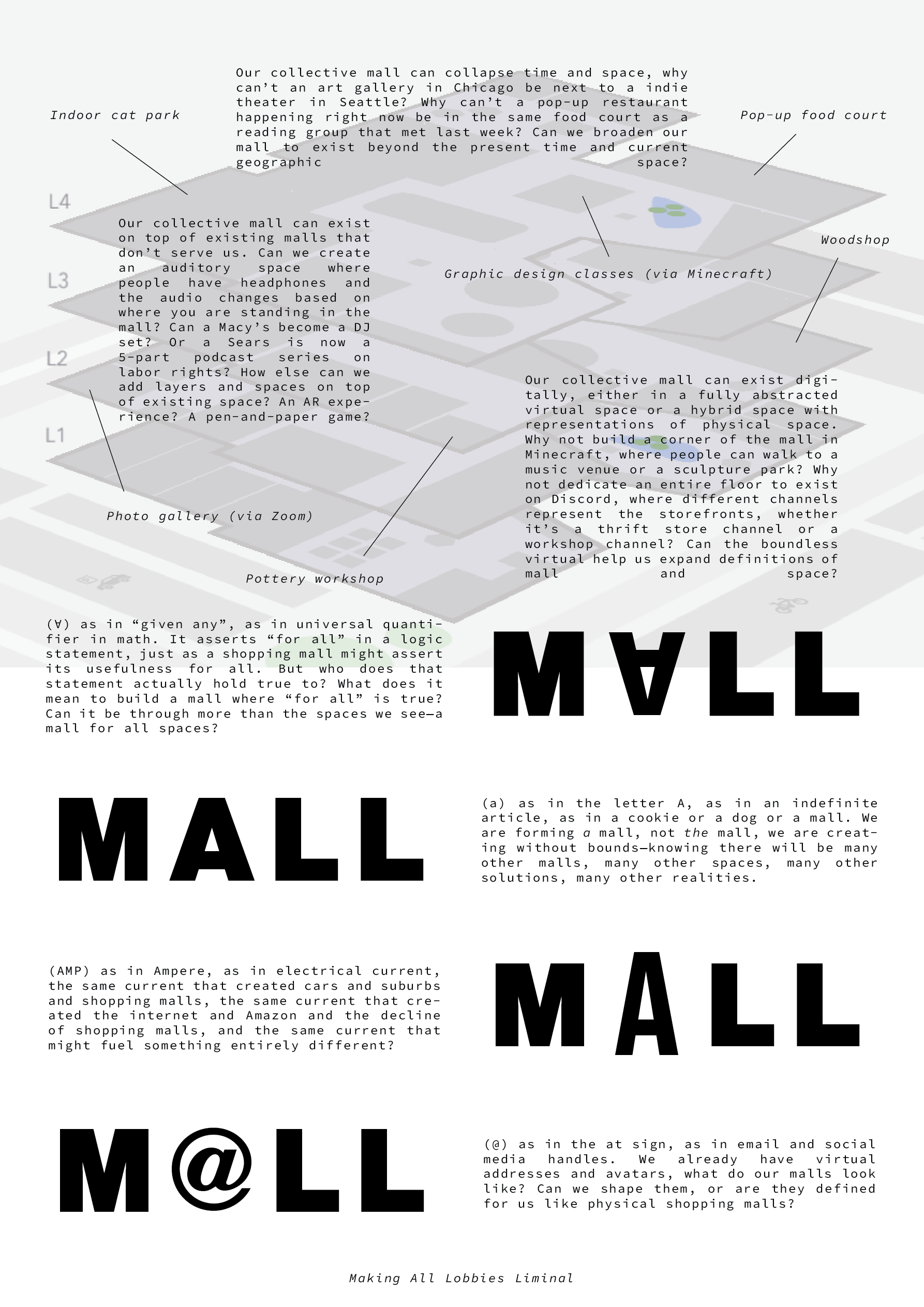| ID | Name | Type |
|---|---|---|
| 37 | Making All Lobbies Liminal | Visual Design |
Details
What do we imagine when we look at a shopping mall? Perhaps it's symbolic of capitalist greed and rot: the large swaths of parking lots, the uninspiring drab exteriors, the never-ending rows of Auntie Anne's and Hot Topic's. Or maybe it's memories of first kisses and loitering around the food court with friends. The shopping mall is the site of contradiction and unfulfilled dreams. The early architect for many suburban shopping malls in the US, Victor Gruen, dreamed of walkable spaces in suburban sprawl, the result is a complicated mess that only further highlight the issues with suburban and capitalist design.
The story of trying to create something generative (walkable spaces, common areas, convenient mixed-use zones), and ending up with something that's quite the opposite (intensely singularly-focused commercial zones, heavily-policed social spaces, endless arrays of parking) is a common story of creating spaces in America. And to find the flower in the concrete, the first ear piercing with friends at Claire's or teenage dates sharing a drink at the A&W's, these experiences are important to remember as intertwined with the messy malls (not necessarily as an endorsement, but a very real link of what it means to create and compromise from within a system).
This makes the exercise of imagining a mall a fascinating one, to understand that our learning and unlearning process of what it means to be together, what it means to exist, is built upon the experiences and encounters of these failed structures. Sometimes these malls show us the absurd arrogance of capital, and give us a target to focus on—as we often do when we dance on decaying malls, and sometimes they demonstrate the warped and complicated ways that we repurpose and reconstitute a space—as we do as teenagers loitering in malls and avoiding mall cops, or as the elderly use it as a safe and accessible walking route.
While people often daydream about their ideal creative studio or cafe, I think the less common idea of dreaming about the mall presents an interesting layer, and obstacle to work through. The association of it as a dull structure, and the sheer scale of it, makes it a daunting task. How often are we going to stumble upon an entire shopping mall for sale? Yet, it's that scale that allows for some inventive and creative thinking. It forces us to think about space as a zone that is intertwined with our surroundings and other people. It challenges questions of how do we dream at scale, or dream in an interconnected fashion. We can imagine a coffeeshop in total isolation from its surrounding space, but there is no mall space that is not in conversation with its neighboring spaces. The premise of the mall requires all of its spaces to consider the meta-space it is in.
In the poster, a proposal is made to imagine a mall, and to imagine it expansively. The proposal states that we can have the collective mall of our dreams, but it will require rethinking what a mall, and what a space can look like. And this rethinking is crucial work to be done, it is work that can sometimes be avoided when we think about our perfect thrift store, or the tea pop-up we want to do in the future. Because to imagine a mall is to imagine a space that can sustain many in a generative way. It requires directly questioning capital, hierarchy, and physical land.
And so maybe the mall of our dreams repurposes an old shopping mall into a mixed-use development. Or maybe it is a hybrid physical and virtual space, merging online workshops with physical galleries. Or maybe it is many spaces spread throughout the city. The mall of our dreams could even be the plans we make along the way. Free from the limited imagination of capital, our collective malls can even transcend time and space. Maybe our past failed workshops can be situated next to our future successful community spaces, and sandwiched in between can be a Cinnabon.

